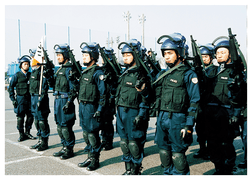Law enforcement in Japan

Law enforcement in Japan is provided by the Prefectural Police under the oversight of the National Police Agency or NPA. The NPA is administered by the National Public Safety Commission, thus ensuring that Japan's police are an apolitical body and free of direct central government executive control. They are checked by an independent judiciary and monitored by a free and active press.
History
The Japanese government established a European-style civil police system in 1874, under the centralized control of the Police Bureau within the Home Ministry, to put down internal disturbances and maintain order during the Meiji Restoration. By the 1880s, the police had developed into a nationwide instrument of government control, providing support for local leaders and enforcing public morality. They acted as general civil administrators, implementing official policies and thereby facilitating unification and modernization. In rural areas especially, the police had great authority and were accorded the same mixture of fear and respect as the village head. Their increasing involvement in political affairs was one of the foundations of the authoritarian state in Japan in the first half of the twentieth century.
The centralized police system steadily acquired responsibilities, until it controlled almost all aspects of daily life, including fire prevention and mediation of labor disputes. The system regulated public health, business, factories, and construction, and it issued permits and licenses. The Peace Preservation Law of 1925 gave police the authority to arrest people for "wrong thoughts". Special Higher Police (Tokko) were created to regulate the content of motion pictures, political meetings, and election campaigns. The Imperial Japanese Army's military police (Kempeitai) and the Imperial Japanese Navy's Tokkeitai, operating under their respective services and the justice and home ministries aided the civilian police in limiting proscribed political activity. After the Manchurian Incident of 1931, military police assumed greater authority, leading to friction with their civilian counterparts. After 1937 police directed business activities for the war effort, mobilized labor, and controlled transportation.
After Japan's surrender in 1945, occupation authorities in World War II retained the prewar police structure until a new system was implemented and the Diet passed the 1947 Police Law. Contrary to Japanese proposals for a strong, centralized force to deal with postwar unrest, the police system was decentralized. About 1,600 independent municipal forces were established in cities, towns, and villages with 5,000 inhabitants or more, and a National Rural Police was organized by prefecture. Civilian control was to be ensured by placing the police under the jurisdiction of public safety commissions controlled by the National Public Safety Commission in the Office of the Prime Minister. The Home Ministry was abolished and replaced by the less powerful Ministry of Home Affairs, and the police were stripped of their responsibility for fire protection, public health, and other administrative duties.
When most of the occupation forces were transferred to Korea in 1950–51 with the Korean War, the 75,000 strong National Police Reserve (predecessor of the Japan Ground Self-Defense Force) was formed outside the Regular police organizations to back up the ordinary police during civil disturbances. And pressure mounted for a centralized system more compatible with Japanese political preferences. The 1947 Police Law was amended in 1951 to allow the municipal police of smaller communities to merge with the National Rural Police. Most chose this arrangement, and by 1954 only about 400 cities, towns, and villages still had their own police forces. Under the 1954 amended Police Law, a final restructuring created an even more centralized system in which local forces were organized by prefectures under a National Police Agency.
The revised Police Law of 1954, still in effect in the 1990s, preserves some strong points of the postwar system, particularly measures ensuring civilian control and political neutrality, while allowing for increased centralization. The National Public Safety Commission system has been retained. State responsibility for maintaining public order has been clarified to include coordination of national and local efforts; centralization of police information, communications, and record keeping facilities; and national standards for training, uniforms, pay, rank, and promotion. Rural and municipal forces were abolished and integrated into prefectural forces, which handled basic police matters. Officials and inspectors in various ministries and agencies continue to exercise special police functions assigned to them in the 1947 Police Law.
Regular police organizations
As of 2016, the NPA has a strength of 7,800 officers: 2,100 police officers, 900 Imperial guards and 4,800 police staff.[1] The total strength of the prefectural police is approximately 287,900 officers: 259,500 police officers and 28,400 police staff.[1] Nationwide, there are approximately 22,000 female police officers and 12,700 female police staff.[1]
National level
National Public Safety Commission
The mission of the National Public Safety Commission is to guarantee the neutrality of the police by insulating the force from political pressure and to ensure the maintenance of democratic methods in police administration. The commission's primary function is to supervise the National Police Agency, and it has the authority to appoint or dismiss senior police officers. The commission consists of a chairman, who holds the rank of minister of state, and five members appointed by the prime minister with the consent of both houses of the Diet. The commission operates independently of the cabinet, but liaison and coordination with it are facilitated by the chairman's being a member of that body.
National Police Agency
As the central coordinating body for the entire police system, the National Police Agency determines general standards and policies; detailed direction of operations is left to the lower echelons.[2] In a national emergency or large-scale disaster, the agency is authorized to take command of prefectural police forces. In 1989 the agency was composed of about 1,100 national civil servants, empowered to collect information and to formulate and execute national policies. The agency is headed by a commissioner general who is appointed by the National Public Safety Commission with the approval of the prime minister.[2]
The Central Office includes the Secretariat, with divisions for general operations, planning, information, finance, management, and procurement and distribution of police equipment, and five bureaus.
- Internal Bureaus
- Community Safety Bureau (生活安全局 Seikatsu Anzen-kyoku)
- Criminal Affairs Bureau (刑事局 Keiji-kyoku)
- Traffic Bureau (交通局 Kōtsū-kyoku)
- Security Bureau (警備局 Keibi-kyoku)
- Info-Communications Bureau (情報通信局 Jōhō Tsūshin-kyoku)
- Local Branch Bureaus and Departments
- Hokkaido Police Info-Communications Department (北海道警察通信情報部 Hokkaidō Keisatsu Tsūshin Jōhō-bu)
- Tohoku Regional Police Bureau (東北管区警察局 Tōhoku Kanku Keisatsu-kyoku)
- Kanto Regional Police Bureau (関東管区警察局 Kantō Kanku Keisatsu-kyoku)
- Tokyo Metropolitan Police Info-Communications Department (東京都警察情報通信部 Tōkyō-to Keisatsu Jōhō Tsūshin-bu)
- Chubu Regional Police Bureau (中部管区警察局 Chūbu Kanku Keisatsu-kyoku)
- Kinki Regional Police Bureau (近畿管区警察局 Kinki Kanku Keisatsu-kyoku)
- Chugoku Regional Police Bureau (中国管区警察局 Chūgoku Kanku Keisatsu-kyoku)
- Shikoku Regional Police Bureau (四国管区警察局 Shikoku Kanku Keisatsu-kyoku)
- Kyushu Regional Police Bureau (九州管区警察局 Kyūshū Kanku Keisatsu-kyoku)
- Subsidiary Organs
- National Police Academy (警察大学校 Keisatsu Dai-gakkō)
- National Research Institute of Police Science (科学警察研究所 Kagaku Keisatsu Kenkyū-sho)
- Imperial Guard Headquarters (皇宮警察本部 Kōgū-Keisatsu Honbu)
Local level
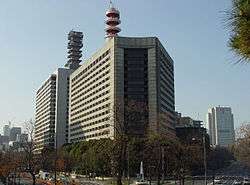
There are some 289,000 police officers nationwide, about 97 percent of whom were affiliated with local police forces. Local forces include:[3]
- forty-three Prefectural (ken) Police Departments;
- Tokyo Metropolitan (to) Police Departments, in Tokyo;
- two urban Prefectural (fu) Police Departments, in Osaka and Kyoto; and
- one district (dō) Police Departments, in Hokkaidō.
These police departments are responsible for every police actions within their jurisdiction in principle, but most important activities are regulated by the National Police Agency. Police officers whose rank are higher than Assistant Commissioner (警視正 Keishi-sei) are salaried by the National budget even if they belong to local police departments. Designation and dismissal of these high-rank officers are delegated to National Public Safety Commission.[4]
The NPA also provides funds for equipment like Police radio systems, riot control action, escort operation, and natural disaster duties, and for internal security and multiple jurisdiction cases. National police statutes and regulations establish the strength and rank allocations of all local personnel and the locations of local police stations. Prefectural police finance and control the patrol officer on the beat, traffic control, criminal investigations, and other daily operations.
Each prefectural police headquarters contains administrative divisions corresponding to those of the bureaus of the National Police Agency. Headquarters are staffed by specialists in basic police functions and administration and are commanded by an officer appointed by the local office of the National Public Safety Commission. Most arrests and investigations are performed by prefectural police officials (and, in large jurisdictions, by police assigned to substations), who are assigned to one or more central locations within the prefecture. Experienced officers are organized into functional bureaus and handle all but the most ordinary problems in their fields.
Local Station Structure
Each District Headquarters commands several police stations. Each station includes the following:[5]
- Administration Section
- Traffic Section
- Security Section
- Community Police Affairs Section
- Criminal Investigation Section
- Community Safety Section
- Organized Crime Control Section
Criminal investigation
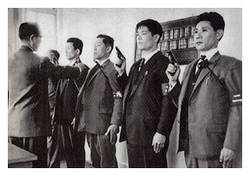
In the Empire of Japan, the criminal investigation was presided over by prosecutors, like the Ministère public does in French law. Then, with the 1947 Police Law and 1948 Code of Criminal Procedure, responsibility of the investigation has been defined that uniquely located at police officers. In order to fulfill this responsibility, Criminal Investigation Departments or Bureaus (Judiciary Police) were set up in each police organization. After the establishment of the 1954 amended Police Law, these departments are supervised by the Criminal Affairs Bureau of the National Police Agency.[6]
Criminal Investigation Departments or Bureaus maintain two Investigation Divisions (捜査課 Sousa-ka) (third or even fourth Divisions are established in some urban prefecture), a Organized Crime Investigation Division (組織犯罪対策課 Soshikihanzai-taisaku-ka) (reinforced as an independent department or headquarters in the TMPD and some prefecture), a Mobile Investigation Unit, and a Identification Division (鑑識課 Kanshiki-ka). The Mobile Investigation Units (機動捜査隊 Kidō Sousa-tai) are primary reaction units for initial criminal investigations, distributed among the region with unmarked cars. The Special Investigation Teams (特殊事件捜査係 Tokushu-jiken Sousa-kakari) are specialized detective units of the First Investigation Divisions, well acquainted with new technology and special tactics including SWAT capabilities.[6]
Public security
Community Safety

Kōbans are substations near major transportation hubs and shopping areas and in residential districts. They form the first line of police response to the public. The Koban system is composed of about 6500 police boxes (Koban) and about 7600 residential police boxes (Chuzaisho).[7] Koban are staffed by a relatively small number of police officers (usually 3-5 officers); a Chuzaisho is usually staffed by a single officer. About 20 percent of the total police force's officers are assigned to koban. Staffed by officers working in eight-hour shifts, they serve as a base for foot patrols and usually have both sleeping and eating facilities for officers on duty but not on watch. In rural areas, residential offices usually are staffed by one police officer who resides in adjacent family quarters. These officers endeavor to become a part of the community, and their families often aid in performing official tasks.
Vigilance at the Koban and Chuzaisho is maintained by standing watch in front or sitting watch inside, enabling police officers to respond immediately to any incident. While keeping a constant watch, they perform a myriad of routine tasks, such as receiving crime reports from citizens, handling lost and found articles, counseling citizens in trouble and giving directions.
Outside their Koban and Chuzaisho, police officers patrol their beats either on foot, by bicycle or by car. While on patrol, they gain a precise knowledge of the topography and terrain of the area, question suspicious-looking persons, provide traffic guidance and enforcement, instruct juveniles, rescue the injured, warn citizens of imminent dangers and protect lost children and those under the influence or intoxicated.
Radio-equipped patrol cars are deployed at each PPH, police station, Koban and Chuzaisho. Police officers use them for routine patrol and rapid response. These cars remain in constant radio contact with their police station and the communications command center of the PPH. When an emergency is reported, this rapid response capability plays a major role in the quick resolution of such incidents.[8]
Officers assigned to koban have intimate knowledge of their jurisdictions. One of their primary tasks is to conduct twice-yearly house-by-house residential surveys of homes in their areas, at which time the head of the household at each address fills out a residence information card detailing the names, ages, occupations, business addresses, and vehicle registration numbers of household occupants and the names of relatives living elsewhere. Police take special note of names of the aged or those living alone who might need special attention in an emergency. They conduct surveys of local businesses and record employee names and addresses, in addition to such data as which establishments stay open late and which employees might be expected to work late. Participation in the survey is voluntary, and most citizens cooperate, but an increasing segment of the population has come to regard the surveys as invasions of privacy.
Information elicited through the surveys is not centralized but is stored in each police box, where it is used primarily as an aid to locating people. When a crime occurs or an investigation is under way, however, these files are invaluable in establishing background data for a case. Specialists from district police stations spend considerable time culling through the usually poorly filed data maintained in the police boxes.
Riot control and counter-terrorism
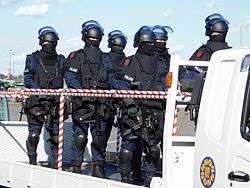
Within their Security Departments or Bureaus, each prefectural police department including the TMPD maintain Riot Police Units (機動隊 Kidō-tai). These units are not only riot police units literally, but also some kind of rapid reaction force for disaster relief or other emergency missions, and reinforcement for regular police when necessary. Full-time riot police can also be augmented by regular police trained in riot duties.[9]
Counter-terrorism operations are also the affairs of the Security Departments. The Special Assault Teams are the national-level units and Anti-firearms squads are the local units.[10] These units are established within the Riot Police Units basically, but Special Assault Teams of the TMPD and Osaka Prefectural Police are under direct control of their Security Bureau or Department. Special Investigation Teams of the Criminal Investigation Departments are mandated for law enforcement missions against heavily armed criminals except terrorists,[11] but in some rural but well-versed Prefectural Police like Aomori, these detectives can form a counter-terrorism task force together with uniformed officers and riot specialists.[12]
Operations of these units are supervised by the Security Bureau of the NPA.[13]
Conditions of service
Education is highly stressed in police recruitment and promotion. Entrance to the force is determined by examinations administered by each prefecture. Examinees are divided into two groups: upper-secondary-school graduates and university graduates. Recruits underwent rigorous training—one year for upper-secondary school graduates and six months for university graduates—at the residential police academy attached to the prefectural headquarters. On completion of basic training, most police officers are assigned to local police boxes called Kobans. Promotion is achieved by examination and requires further course work. In-service training provides mandatory continuing education in more than 100 fields. Police officers with upper-secondary school diplomas are eligible to take the examination for sergeant after three years of on-the-job experience. University graduates can take the examination after only one year. University graduates are also eligible to take the examination for inspector, chief inspector, and superintendent after shorter periods than upper-secondary school graduates. There are usually five to fifteen examinees for each opening.
About fifteen officers per year pass advanced civil service examinations and are admitted as senior officers. Officers are groomed for administrative positions, and, although some rise through the ranks to become senior administrators, most such positions are held by specially recruited senior executives.
The police forces are subject to external oversight. Although officials of the National Public Safety Commission generally defer to police decisions and rarely exercise their powers to check police actions or operations, police are liable for civil and criminal prosecution, and the media actively publicizes police misdeeds. The Human Rights Bureau of the Ministry of Justice solicits and investigates complaints against public officials, including police, and prefectural legislatures could summon police chiefs for questioning. Social sanctions and peer pressure also constrain police behavior. As in other occupational groups in Japan, police officers develop an allegiance to their own group and a reluctance to offend its principles.
Ranks
Police officers are divided into nine ranks:[14]
| Status | Police ranks[14] | Comparable military ranks[15] | Representative job titles |
|---|---|---|---|
| Government officials |
Commissioner General (警察庁長官 Keisatsu-chō Chōkan) | No counterpart (outside normal ranking) | The Chief of the National Police Agency |
| Superintendent General (警視総監 Keishi-sōkan) | General | The Chief of the Metropolitan Police Department | |
| Senior Commissioner (警視監 Keishi-kan) | Lieutenant general | Deputy Commissioner General, Deputy Superintendent General, The Chief of Regional Police Bureau, The Chief of Prefectural Police Headquarters | |
| Commissioner (警視長 Keishi-chō) | Major general | The Chief of Prefectural Police Headquarters | |
| Assistant Commissioner (警視正 Keishi-sei) | Colonel | The Chief of Police Station | |
| Local police personnel | Superintendent (警視 Keishi) | Lieutenant colonel | The Chief of Police Station (small or middle), The Vice Commanding Officer of Police Station, Commander of Riot Police Unit |
| Chief Inspector (警部 Keibu) | Major or Captain | Squad Commander of Police Station, Leader of Riot Company | |
| Inspector (警部補 Keibu-ho) | Captain or Lieutenant | Squad Sub-Commander of Police Station, Leader of Riot Platoon | |
| Police Sergeant (巡査部長 Junsa-buchō) | Warrant officer or Sergeant | Field supervisor, Leader of Police box | |
| Senior Police Officer (巡査長 Junsa-chō) | Corporal | (Honorary rank of Police Officers) | |
| Police officer (巡査 Junsa) | Private | Prefectural Police Officer's career start from this rank. |
The NPA Commissioner General holds the highest position of the Japanese police.[16] His title is not a rank, but rather denotes his position as head of the NPA. On the other hand, the MPD Superintendent General represents not only the highest rank in the system but also assignment as head of the Tokyo Metropolitan Police Department.[16]
Law enforcement officials outside regular police organizations
In addition to regular police officers, there are several thousand officials attached to various agencies who perform special duties relating to public safety. They are responsible for such matters as forest preservation, narcotics control, fishery inspection, and enforcement of regulations on maritime, labor, and mine safety.
Special judicial police officials (特別司法警察職員)
Cabinet Office
Ministry of Justice
- Prison guard (刑務官)
Ministry of Health, Labour and Welfare
Ministry of Agriculture, Forestry and Fisheries
- Authorized Fisheries Supervisor (漁業監督官)
- Officers of Regional Forest Office, under Forestry Agency (林野庁森林管理局職員)
Ministry of Economy, Trade and Industry
- (鉱務監督官)
Ministry of Land, Infrastructure, Transport and Tourism
Coast Guard Officer (海上保安官)
The largest and most important of these ministry-supervised public safety agencies is the Japan Coast Guard, an external agency of the Ministry of Land, Infrastructure, Transport and Tourism that deals with crime in coastal waters and maintains facilities for safeguarding navigation. The agency operates a fleet of patrol and rescue craft in addition to a few aircraft used primarily for anti-smuggling patrols and rescue activities. In 1990 there were 2,846 incidents in and on the waters. In those incidents, 1,479 people drowned or were lost and 1,347 people were rescued.
- (船員労務官)
Ministry of Defense
- Military police officer (警務官)
Officials working for public safety, except for Special judicial police officials
There are other officers having limited public safety functions.
The National Diet
- Diet guard (衛視)
Ministry of Justice
Public security intelligence officer (公安調査官)
They handle national security matters both inside and outside the country. Its activities are not generally known to the public.
Ministry of Finance
- Customs official (税関職員)
- Officers of National Tax Agency (国税庁職員)
Ministry of Health, Labour and Welfare
- Quarantine Officer (検疫官)
Ministry of Agriculture, Forestry and Fisheries
Tables
| Officer | are Special judicial police officials (特別司法警察職員) | can arrest suspects with arrest warrant | can carry firearms | Salary schedule which is applied |
|---|---|---|---|---|
| Imperial guard (皇宮護衛官) | Public Security Service | |||
| Prison guard (刑務官) | Public Security Service | |||
| Narcotics agent (麻薬取締官) | Administrative Service | |||
| Labor Standards Inspector (労働基準監督官) | Administrative Service | |||
| Authorized Fisheries Supervisor (漁業監督官) | Administrative Service | |||
| Coast Guard Officer (海上保安官) | Public Security Service | |||
| Military police officer (警務官) | Officials of Ministry of Defense | |||
| Diet guard (衛視) | (議院警察職) | |||
| Immigration control officer (入国警備官) | Public Security Service | |||
| Immigration inspector (入国審査官) | Administrative Service | |||
| Public security intelligence officer (公安調査官) | Public Security Service | |||
| Public prosecutor (検察官) | Public Prosecutor | |||
| Public prosecutor's assistant officer (検察事務官) | Public Security Service | |||
| Customs official (税関職員) | Administrative Service | |||
| cf.) Police officer | (judicial police official) | Public Security Service |
Equipment
Uniform
For much of the twentieth century up to the mid-1990s, police officers wore a formal work uniform consisting of a tunic or Ike jacket with polished silver buttons, and trousers with a sewn in truncheon pocket. No stab vest was worn and much less equipment was carried than is today. Following concerns about the police uniforms safety it was suggested that the uniform should be changed.
From the 1990s it was generally accepted that the police could patrol in "shirt-sleeve order" which meant that they need not wear the jacket, as its widespread use was hampering in some situations. The NPA, in agreement with the government and on the cooperation of the Prefecture Chiefs of Police, changed the uniform from the business attire with no protection of the torso, to a uniform of button down shirt with trousers, stab vest, duty belt, and jacket when needed.
Although there are minor variations in the styling, pattern and insignia, the police forces all wear very similar uniforms. In general, these have taken their lead from the Tokyo Metropolitan Police, due to it being the largest police service in Japan. The base color is a dark blue or a frosted grey for summer wear.
Female officers' uniforms have gone through a great variety of styles, as they have tended to reflect the women's fashions of the time. Tunic style, skirt length and headgear have varied by period and force. By the late 1980s, the female working uniform was virtually identical to male, except for headgear and sometimes neckwear.
Formal uniform comprises an open-necked tunic (with or without an attached belt, depending on the force and rank of the Officer) and trousers or skirt, worn with a white or light blue shirt and black tie (usually clip-on, so it cannot be used to strangle the wearer).
The normal working dress retains the shirt and trousers. In some forces short sleeved shirts may be worn open-necked. Long sleeved shirts must always be worn with a tie, worn with or without a jersey or fleece. If a jersey, fleece or jacket is worn over a short sleeved shirt, then a tie must be worn.
Today, female officers almost never wear a skirt in working dress, and frequently wear trousers in formal dress as well. Officers also frequently wear reflective waterproof jackets, which have replaced the old greatcoats and cloaks traditionally worn in inclement weather. Most officers now wear stab vests, a type of body armour, when on duty.
Basic headgear is a peaked cap for men, and a soft round bowler hat for women. Traffic officers wear white cap covers or caps.
Most Japanese police wear white gloves while they are on duty. Some also wear white pistol belts, lanyards, helmets, boot laces or leggings.
Service weapon
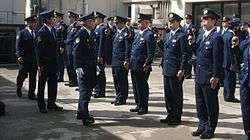
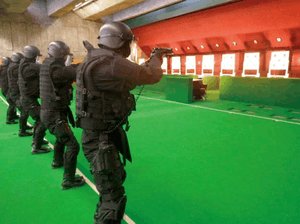
In the pre-war era, most Japanese law enforcement officials had only a sabre. Only some elite detectives, bodyguards, or SWAT units such as the Emergency Service Unit of the TMPD were issued pistols. FN Model 1910 or Colt Model 1903 were used for open-carry uses, and Colt Model 1908 Vest Pocket or FN M1905 for concealed carry. During the Occupation, the Supreme Commander for the Allied Powers suggested them to be equipped with firearms. Because of the insufficient stocks of the domestic handguns, Japanese police started to receive service pistols leased from the Allies from 1949, and by 1951, all officers were issued pistols.[17]
At the beginning, types of sidearm varied, but M1911 pistols and M1917 revolvers, Smith & Wesson Military & Police and Colt Official Police were used as the main sidearm. The .38 caliber revolvers were well-received, but .45 caliber handguns were too large to carry for somewhat small officers especially women. And especially M1917 revolvers were obsolete, deteriorated significantly, so malfunction or reduced accuracy had been a problem. As a response to these issues, the National Rural Police Headquarters (one of the predecessors of the National Police Agency) started to import small .38 Special caliber revolvers such as Smith & Wesson Chiefs Special and Colt Detective Special. And from the 1960s, procurement began to migrate to the domestic Minebea "New Nambu" M60. When the production of the M60 was completed in the 1990s, deployment of small semi-automatic pistols were considered, but this plan was abandoned after small numbers of SIG Sauer P230 were deployed. Finally, imports from the United States was resumed, S&W M37 and M360 revolvers have been purchased for uniformed officers. And some elite detectives, bodyguards, or counter-terrorism units such as the Special Assault Team are equipped with 9×19mm Parabellum caliber semi-automatic pistols, Heckler & Koch USP, for example.[18]
From 1970s, Special Armed Police units (ancestors of the Special Assault Teams) introduced Heckler & Koch MP5 submachine guns. And from 2000s, local counter-terrorism units (Anti-firearms squads) and SWAT units of crime branches (Special Investigation Team of the TMPD, for example) were started to be equipped with MP5. In the SAT units, there are also assault rifles.[18]
Initially the sniper team was established in the 1960s, the Golden Bear has been used as a sniper rifle, then, it has been updated to the M1500. In the Special Assault Teams, Heckler & Koch PSG1 and L96A1 also been deployed.[18]
In the Japanese police, service pistols are generally left at work when they are not on duty.[19]
Transportation
Ground
In Japan, there are about 40,000 police vehicles nationwide with the average patrol cruisers being Toyota Crowns and similar large sedans, although small compact and micro cars are used by rural police boxes and in city centers where they are much more maneuverable. Pursuit vehicles depend on prefectures with the Honda NSX, Subaru Impreza, Subaru Legacy, Mitsubishi Lancer, Nissan Skyline, Mazda RX-7, and Nissan Fairlady Z are all used in various prefectures for highway patrols and pursuit uses.
With the exception of unmarked traffic enforcement vehicles, all Japanese police forces are painted and marked in the same ways. Japanese police vehicles are painted black and white with the upper parts of the vehicle painted white. Motorcycles are usually all white and riot control and rescue vehicles are painted a steel blue.
 Nissan Crew Police Car
Nissan Crew Police Car Saitama prefecture Toyota Crown Traffic Police Car
Saitama prefecture Toyota Crown Traffic Police Car Suzuki Address V125 Police Scooter
Suzuki Address V125 Police Scooter
- Unmarked Mitsubishi Delica Space Gear Police Van
- Security Police officer in a Mercedes-Benz S600 during escort duty at the 34th G8 summit in Tōyako, Hokkaidō.
 Toyota Land Cruiser Kidotai (Riot Police) Unit
Toyota Land Cruiser Kidotai (Riot Police) Unit Mitsubishi Fuso Fighter Kidotai (Riot Police) Unit
Mitsubishi Fuso Fighter Kidotai (Riot Police) Unit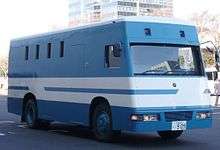 Isuzu Giga Kidotai/Prisoner Transport Unit
Isuzu Giga Kidotai/Prisoner Transport Unit Hino Ranger / Rescue truck
Hino Ranger / Rescue truck Unimog / Multi-purpose disaster management truck
Unimog / Multi-purpose disaster management truck Mitsubishi Fuso Canter / NBC defense truck
Mitsubishi Fuso Canter / NBC defense truck
Aviation
Helicopters are extensively used for traffic control surveillance, pursuit of suspects, rescue and disaster relief. Total of 80 small and medium-sized helicopters are being operated in 47 prefectures nationwide.
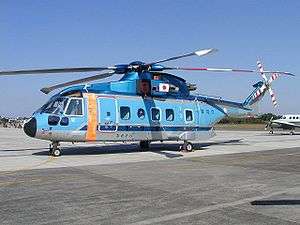
 Agusta A109E, Hokkaidō Police
Agusta A109E, Hokkaidō Police Eurocopter AS365 N2, Osaka Police
Eurocopter AS365 N2, Osaka Police
Watercraft
Japanese police boats are deployed to major ports, remote islands and lakes, where they are used for water patrol and control of illegal immigration, smuggling and poaching. Ranging from five to 23 meters long, there are about 190 police boats nationwide.
 Nagasaki Prefectural Police
Nagasaki Prefectural Police- Hokkaido Police
 Hyōgo Police
Hyōgo Police
Police-community relations
Despite legal limits on police jurisdiction, many citizens retain their views of the police as authority figures to whom they can turn for aid. The public often seeks police assistance to settle family quarrels, counsel juveniles, and mediate minor disputes. Citizens regularly consult police for directions to hotels and residences—an invaluable service in cities where streets are often unnamed and buildings are numbered in the order in which they have been built rather than consecutively. Police are encouraged by their superiors to view these tasks as answering the public's demands for service and as inspiring community confidence in the police. Public attitudes toward the police are generally favorable, although a series of incidents of forced confessions in the late 1980s raised some concern about police treatment of suspects held for pretrial detention.
Historical secret police organizations
- Tokko (Investigated and controlled political groups and ideologies deemed to be a threat to public order)
- Kempeitai (Military Police of the Imperial Japanese Army)
- Tokkeitai (Military Police of the Imperial Japanese Navy)
See also
| Wikimedia Commons has media related to Law enforcement in Japan. |
- Shinsengumi (a special police force of the late shogunate period)
References

- 1 2 3 https://www.npa.go.jp/english/kokusai/pdf/Police_of_Japan_2017_5.pdf
- 1 2 "Interpol Japan Page". Interpol. Retrieved 2012-02-15.
- ↑ "Public Safety Commission System and Police Activity Support" (PDF). Japanese National Police Agency. Archived from the original (PDF) on 2012-02-16. Retrieved 2012-02-15.
- ↑ "Outline of the police system" (PDF). Union of Kansan Gavernments. Retrieved 28 December 2016.
- ↑ https://web.archive.org/web/20171117092458/http://www.keishicho.metro.tokyo.jp/multilingual/english/about_us/graph_keishicho/index.files/18.pdf
- 1 2 National Police Agency Police History Compilation Committee, ed. (1977). Japan post-war police history (in Japanese). Japan Police Support Association. p. 320.
- ↑ "Japanese Community Police and Police Box System". Japanese National Police Agency. Retrieved 2012-02-15.
- ↑ C.D. Alexander Evans (2011-05-11). "What Keeps the Japanese People Together". Dissent Magazine. Archived from the original on 2011-05-19. Retrieved 2012-02-15.
- ↑ National Police Agency, ed. (2004). "The Riot Police Units". Fifty years of the peace preservation police (in Japanese).
- ↑ http://next.spotlight-media.jp/article/319975003749388691
- ↑ Kakitani, Tetsuya; Kikuchi, Masayuki (2008). Japanese counter-terrorism units (in Japanese). Sanshusha Co.,Ltd. pp. 18–26. ISBN 978-4384042252.
- ↑ Masashi Otuka (January 2009). "First public exhibition of the TST". Strike and Tactical Magazine (in Japanese language). KAMADO: 10–11.
- ↑ "Chapter IV. Maintenance of Public Safety and Disaster Countermeasures" (PDF). Japanese National Police Agency. Archived from the original (PDF) on 2011-03-26. Retrieved 2011-03-25.
- 1 2 "4. Human Resources" (PDF). (警察庁) National Police Agency. National Police Agency. Archived from the original (PDF) on 2016-10-25. Retrieved 2018-08-13.
- ↑ "Insignia of the JSDF personnel". JSDF Kumamoto Provincial Cooperation office. Japan Self Defense Force. Retrieved 15 November 2016.
- 1 2 "Description of the Japanese Police Organization". Archived from the original on 2011-07-06. Retrieved 2012-02-15.
- ↑ Eiji Takemae (2000). History of the non-military activities of the Occupation of Japan, 1945-1951 (15) (in Japanese language). Nihon Tosho Center. p. 58. ISBN 978-4820565376.
- 1 2 3 Masatsugu Otsuka (January 2009). "Guns of the Japanese police". Strike and Tactical Magazine (in Japanese language). KAMADO. 6 (1): 50–57.
- ↑ Richard J. Terrill (2012). World Criminal Justice Systems: A Comparative Survey. Routledge. p. 214. ISBN 9781455725892.
- Reference to Kidotai force:
- Yoshino, Jun. (2004). "Law Enforcement in the Edo Period". In: Japan Echo, vol. 31 n. 3, June 2004. p. 59-62.
External links
- NPA Official Site (Japanese)
- NPA Official Site (English)
- Imperial Guard Headquarters
Regional Bureaus
- Kanto Regional Police Bureau
- Chubu Regional Police Bureau
- Kinki Regional Police Bureau
- Chugoku Regional Police Bureau
- Shikoku Regional Police Bureau
- Kyushu Regional Police Bureau
Police communications Bureaus
Kobans
